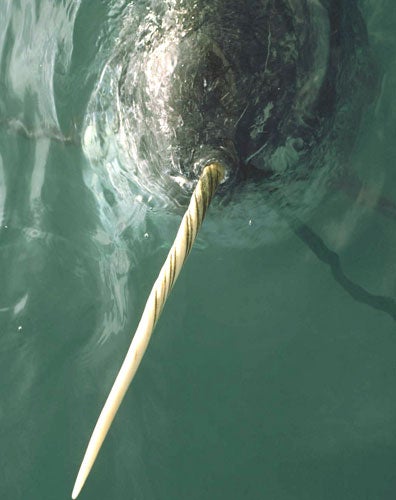War against ivory trade takes to the sea
Auction house agrees to stop sale of whale tusks after pressure from campaigners

It's the "other" ivory. And this week, conservationists in London stepped in to stop its sale. It might not be as well known as the stuff that comes from elephants, but the ivory from the narwhal, the tusked whale of the northern seas, is just as much in demand – and with that demand comes a threat just as severe as the one elephants face.
Not only is the narwhal's single spear-like tusk (which can be 8ft long) an object of great beauty, it is the object of myth and legend – in the Middle Ages it was considered to come from the unicorn – and so is highly prized by collectors. The demand for tusks is increasing and, as a result, so is hunting in the narwhal's core area of northern Canada and Greenland.
Campaigners from the Whale and Dolphin Conservation Society (WDCS) believe the rising hunting rate is a threat to the animal and so when seven narwhal tusks were entered into a major antiques sale at Bonhams, the London auction house, this week – where they were expected to fetch up to £10,000 each – they pressed for them to be withdrawn. The company agreed to do so; now the campaigners are calling on Bonhams to exclude narwhal tusks permanently, although the auction house confined itself to saying the tusks were withdrawn from the sale "for procedural reasons" and gave no indication about future policy.
"We welcome Bonhams' decision to remove the narwhal tusks from sale, and we hope that the company will extend this decision to future sales both at its UK auction houses and overseas salerooms," said Chris Butler-Stroud, the WDCS chief executive.
The tusks were entered in The Gentleman's Library Sale, an annual auction bringing together natural history curiosities of the sort that might have adorned the library or the smoking room of a wealthy Victorian; when it took place on Wednesday, the full sale of more than 1,000 items – featuring items from antique globes to antlered deer heads – raised nearly £900,000.
WDCS believes that the seven tusks originally listed for auction would have represented the largest single offering of narwhal ivory in the UK since the European Union banned its import from Canada in 1984 and limited imports from Greenland to personal effects only (ie, not for resale) in 2004.
Although elephant ivory is banned from general sale, apart from in specially licensed auctions – one such took place last year – the sale of narwhal ivory is still legal, although the trade has to be monitored. But the WDCS believes that demand is steadily growing, with prices rising accordingly, and that this is pushing native peoples in artic Canada and Greenland to hunt more and more of the animals.
One of the main narwhal populations in Greenland has been listed as critically endangered on Greenland's Red List of Species, and in 2008, the International Union for the Conservation of Nature, cited over-hunting as the major threat and warned that the species as a whole could become "endangered" or "critically endangered" within five years.
The society has also contacted Bonhams' US branch, Bonhams and Butterfields, with its concerns, as it has sold at least four narwhal tusks at its Los Angeles salesroom in the past two years, for prices ranging from $11,000 (£8,000) to $20,400 for a single tusk.
"The publicity surrounding sales such as these, and the high prices fetched by the tusks, adds to the motivation for hunters to take as many narwhals as possible, and for management agencies to set quotas way above sustainable levels," Mr Butler-Stroud said.
Kate O'Connell, a WDCS researcher in the United States, said: "I think most people would find it abhorrent that such a trade should impact on such a beautiful animal."
Narwhals: The facts
The narwhal ( Monodon monoceros) is a toothed whale closely related to the all-white beluga. Its single tusk is an elongated incisor tooth that in fully-grown males ranges from 7ft to 10ft long. An exclusively arctic species, it is hunted only in Canada and Greenland, where between 300 and 500 animals are taken annually by native people. However, last November, hundreds of narwhals were trapped in the ice on the northern coast of Baffin Island, perhaps because the ice-formation regime in the arctic is being altered by climate change. Eventually all 629 were killed by Inuit hunters.
Join our commenting forum
Join thought-provoking conversations, follow other Independent readers and see their replies
Comments